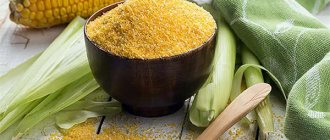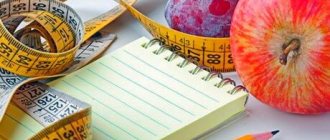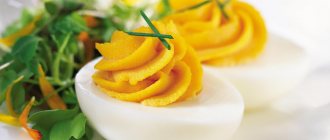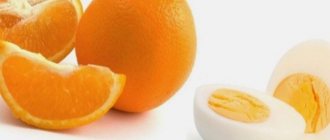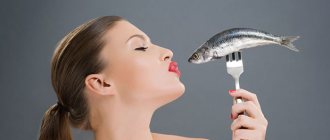The figure of an athlete involved in rhythmic gymnastics always causes admiration and is an incentive for those who dream of losing weight. One of the main criteria is the proper nutrition of gymnasts, which is aimed not only at limiting the gain of extra pounds, but also maintaining body tone after long and rather grueling training.
Food intake plays a very important role in proper metabolism.
The main tasks of proper nutrition for gymnasts:
- All food consumed should be fully enriched with nutrients that do not affect body weight;
- The weight of the athlete should not exceed 50 kg;
- The proportion of muscle mass should not affect the athlete’s plasticity;
- The proportion of fat from total body weight should be low.
The essence of the diet

In pursuit of a beautiful figure, one should not forget one fact - gymnastics is a sport, and professional athletes are obliged to adhere to proper and balanced nutrition so that they can not only develop harmoniously, but also have the strength to exercise. The diet of rhythmic gymnasts is extremely important, since it often determines whether a girl can set a new record.
In addition, the main objectives for such nutrition are the following tenets.
- Weight support for gymnasts (45-50 kilograms).
- The daily menu should be filled with ingredients that contain a large amount of nutrients, but at the same time they should not have an effect on body weight.
- The percentage of fat mass in the body should be kept to a minimum.
- The percentage of muscle mass should be relatively small so as not to in any way affect the flexibility and grace of girls, and also not to prevent them from moving energetically.
In fact, the diet of gymnasts is quite good for losing weight, even though you need to eat 4 meals a day.
Champion Recipes
A diet for weight loss, like the diet of gymnasts, excludes all kinds of sweets, smoked foods and fried foods. But this does not mean that those who watch their figure or play sports have absolutely nothing to eat, and their diet is stingy and monotonous. Representatives from rhythmic gymnastics and other athletes come up with their own recipes for low-calorie dishes.
Vegetable ratatouille with chicken breast
As you know, breast is a low-fat product and will not affect your figure, but will provide the body with energy. To prepare you need:
- One bell pepper;
- Chicken breast weighing 300 grams;
- 2-3 cloves of garlic;
- Half an onion;
- One eggplant;
- One yellow zucchini;
- Two medium tomatoes;
- Fresh parsley;
- Two bay leaves;
- Balsamic vinegar dessert spoon;
- A little salt to cook's taste;
- Black, ground pepper is not for everyone.
Cut the pepper and peeled tomato into cubes, chop the onion, which is then lightly sautéed in olive oil. Squeeze the garlic into the pan, add bell peppers, tomatoes, black pepper, bay leaves, and thyme. Cut chicken, zucchini and eggplant into cubes and place in layers on previously prepared vegetables. The dish is cooked in the oven at 200 degrees until a beautiful, golden crust is formed. After cooking, sprinkle the baked vegetables on top with chopped parsley, which had to be pre-mixed with ground pepper and olive oil.
Every diet requires fluid intake. Athletes themselves love to prepare energy drinks, which are recommended for weight loss.
Drink with ginger and lemon
Grate two or three centimeters of ginger root on a fine grater and place in a 1-liter thermos. Pour boiling water over and leave for exactly one hour. Open the thermos, add the juice of one lemon and two tablespoons of honey, stir, and cool. It is recommended to strain the finished drink. You will appreciate the taste and benefits immediately.
Authorized Products

Now let’s talk about exactly what foods are allowed to be consumed in a gymnast’s diet. There are quite a few of them, so they are usually divided into several groups:
- Fermented milk products with very low fat content or completely fat-free.
- Fresh vegetables, fruits, herbs and berries. They don’t even cook them, but only eat them raw, with rare exceptions.
- Lean fish and meats, such as chicken or turkey.
- Also on the diet of gymnasts, it is necessary to be very careful about the liquid consumed during the day. They mainly rely on melted or table water, rosehip infusions without sugar and natural freshly squeezed juices.
- A variety of cereals, but pearl barley, buckwheat and oatmeal are the best.
Growth in rhythmic gymnastics
There is no such official concept of “ideal height,” but on average, a well-formed gymnast is considered to be between 164 and 170 cm tall. Olympic champion Alina Kabaeva is 164 cm tall, 2008 Olympic bronze medalist Anna Bessonova is 174 cm tall. Therefore, the athlete’s abilities play a big role. Taller gymnastics are “in fashion,” but not “tall.”
The height of famous gymnasts:
- Yana Kudryavtseva 173 cm
- Margarita Mamun 170 cm
- Dina, Arina Averina 164 cm
- Alexandra Soldatova 174 cm
- Laysan Utyasheva 167 cm
- Alina Kabaeva 164 cm
- Irina Chashchina 165 cm
- Anna Rizatdinova 173 cm
- Inna Zhukova 170 cm
- Lyubov Cherkashina 173 cm
- Ekaterina Serebryanskaya 178 cm
- Tamara Erofeeva 178 cm
- Natalya Godunko 178 cm
- Evgeniya Kanaeva 172 cm
- Alina Maksimenko 177 cm
- Melitina Staniuta 172 cm
- Daria Kondakova 169 cm
- Olga Kapranova 177 cm
- Aliya Garayeva 160 cm
- Daria Dmitrieva 174 cm
The average height of international gymnasts from our sample is 171.4 cm. For comparison, the average height of Russian women is 165.3 cm, that is, the gymnasts are above average.
Comparison of the average height of Russian women and rhythmic gymnasts
Being tall in gymnastics has its pros and cons. It has been noticed that short gymnasts are more capable of differentiated speed of movements than tall gymnasts, since the “lever” is smaller and it is easier to maintain speed and perform movements and risks at speed. Simply put, the shorter the arms and legs, the faster you can move them. Tall gymnasts are more suitable to the image of the female ideal, which is not directly, but indirectly assessed by the judges.
Prohibited Products
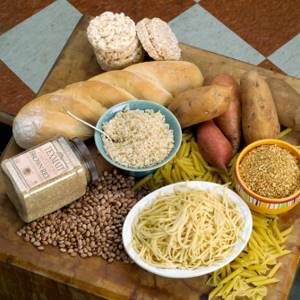
The following foods should be completely excluded from the diet of gymnasts if girls want to maintain a beautiful figure. These include:
- Alcoholic drinks.
- Fatty meats.
- Products with a high content of preservatives, such as chips, ketchup, store-bought yogurt, canned foods and other semi-finished products.
- Pickles and other foods that contain a large amount of salt, as they lead to fluid retention in the body, which leads to extra pounds.
- Any pasta and bakery products.
First of all, a gymnast’s diet should be based on protein foods, not carbohydrates, so the vast majority of foods simply cannot be consumed.
Who is suitable for rhythmic gymnastics?
Only girls are accepted into rhythmic gymnastics.
Firstly, the age of future athletes is taken into account; it is advisable to bring children to the selection at the age of 4-5 years. Secondly, girls are judged by their appearance. Slender and tall girls have an advantage.
It is desirable that the baby has an ear for music and a sense of rhythm. The character of the child is important; children with character are chosen, persistent and assertive. Crying and whining children will be quickly weeded out.
A significant quality is coordination of movements. In the future, the gymnast will have to work with sports equipment, so at the beginning of the journey it is advisable to find out whether the child can handle it.
A good memory is essential when choosing gymnasts. The future gymnast must perfectly remember in what order and to what musical fragment to perform the elements during the performance.
In addition, future gymnasts are tested for flexibility, plasticity and turnout. A good coach determines the potential of a young athlete in 3-4 weeks. If your child does not fit the parameters considered, then do not despair. There have been cases when girls who do not have good abilities achieve greater success than talented ones, due to the fact that from childhood they get used to overcoming themselves.
Diet
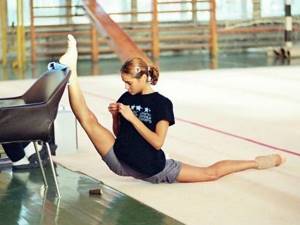
Such sports diets are primarily based on a fairly strict time limit for food intake. You need to eat four meals a day so that you don’t feel hungry during the day. Food should be balanced, but the portions should be quite small.
Approximate daily routine:
- Breakfast from 7:30 to 8:00.
- Snack from 11:00 to 11:30.
- Lunch from 14:30 to 15:30.
- Dinner can take place at any time (even after 18:00), but you should not eat at least 2 hours before bedtime.
Such time frames are quite arbitrary, but it is better to configure the body so that it receives nutrition at the same time.
When to send your child to classes
The age for practicing rhythmic gymnastics depends on your goals. If the goal is professional sports, then the sooner you bring your child, the better.
At what age is it advisable to start classes? At 3 years old, rhythmic gymnastics teachers consider only independent and smart children. At this age, it is worth bringing your child to one-hour classes twice a week. At the same time, one of the parents should be within walking distance from the sports school in order to pick up the child from classes at any time.
This is the ideal age to enroll your child in rhythmic gymnastics. If a child has very good physical data, they can consider it at 7-8 years old.
Provided that gymnastics is considered an amateur section, you can try to come to a sports school later, but preferably before adolescence; after 14 years, it is difficult to stretch a girl’s muscles to the required level.
Menu building rules
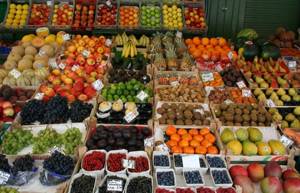
In order to properly use the diet of gymnasts, you need to be very careful when drawing up the daily menu. Each meal is aimed at obtaining certain substances.
- During breakfast, priority is given to carbohydrates so that girls have enough energy for difficult workouts. It is advisable to include cottage cheese, porridge and various fruits in the menu. In addition, most athletes drink a special drink at the beginning of the day, which consists of lemon juice and honey - it gives a boost of energy and vigor.
- For snacks, gymnasts usually use freshly squeezed juices, as well as fruits and nuts.
- Lunch is aimed at getting enough protein for the body. At this meal it is allowed to eat lean meat or fish, and use vegetables as a side dish. Apart from this, you can eat small amounts of fruits or dried fruits to get glucose.
- Dinner should be quite light, so usually girls eat only a salad of vegetables or fruits, and can also afford fermented milk products.
It is on these listed dogmas that the menu should be built.
Basic principles
When compiling the menu, the following provisions are taken into account:
- Low-calorie foods are taken, then body weight will remain normal.
- Preference is given to products with a high protein content, then muscle mass will be preserved and extra pounds will not accumulate.
- The menu should always include legumes, fish dishes, lean meat, and milk.
- Fried and smoked foods, flour products, and sweets are strictly prohibited.
- For sweets, you can only have marmalade based on natural ingredients, dried fruits, dark chocolate, because it speeds up energy metabolism.
- Eat small meals because it promotes rapid digestion of food.
- Strict diet.
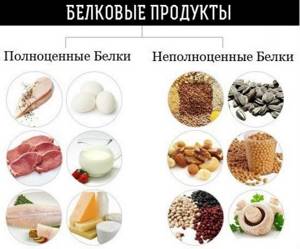
The diet for weight loss includes the same foods as the diet for gymnasts. If someone wants to lose extra pounds this way, then it is necessary to study all the intricacies of the method.
Breakfast
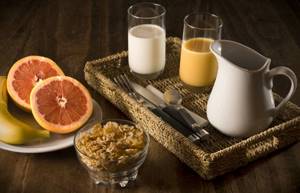
About half an hour before meals you need to drink about 150 ml of water with the addition of a teaspoon of honey and lemon juice.
After this, you can start breakfast. The best option would be a portion of oatmeal porridge cooked in water. Additionally, you should add about 100 grams of low-fat cottage cheese with a teaspoon of raisins and rye bread with low-fat cheese. Green tea with lemon is served as a drink.
The main risks of doing rhythmic gymnastics
Nervous breakdowns: very common in rhythmic gymnastics due to enormous loads and extreme psychological pressure. Hours of training, tournaments, training camps, strict and demanding coaches, ambitious parents and difficult relationships in the women's team - to withstand all this, you must have a truly iron character. That is why only a few will reach the title of Master of Sports in gymnastics.
Clubs: These are the heaviest of the items, each weighing 150 grams. Very often during the program the gymnast throws clubs and catches them. One mistake and you can easily get hit on the head with a mace.
Allergies: from a very early age, gymnasts begin to use decorative cosmetics: mascara, eye shadow, lipstick, blush. The hair is pulled back into an updo and secured with a strong-hold hairspray, sometimes with glitter. All this can develop or provoke an allergy to cosmetic products.
Diet for gymnasts from Irina Winner
Irina Viner is not only the president of the All-Russian Rhythmic Gymnastics Federation, but also a professional trainer and nutritionist. She created her own special diet, which she used to quickly lose weight before competitions. In total, you need to sit on it for no more than 3 days and consume only 2 products - green tea and buckwheat.
For breakfast, buckwheat is consumed, which is not boiled, but only soaked in boiling water for 2 hours. Throughout the rest of the day, you need to drink 2 to 3 liters of green tea, and this should be done before 6 pm. After this, neither drinking nor eating is allowed. On such a diet you can lose about 5 kilograms in a short period of time.
Secrets of a beautiful figure
Athletes in rhythmic gymnastics owe their slim and graceful figure not only to a regular amount of training, but also to healthy food, which must be consumed in accordance with all the rules of a healthy diet. The most important thing is the presence of a large amount of protein in foods. These include poultry, eggs, milk and legumes. A necessary condition for maintaining the body's energy expenditure is the consumption of cereals, among which buckwheat, oatmeal and pearl barley porridge are recommended.
Useful tips
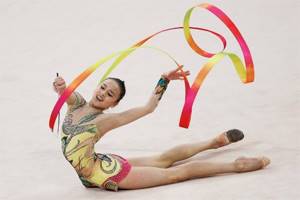
It should be remembered that usually very petite girls become gymnasts, but even they must have strong muscles to perform tricks. That is why proper nutrition is so important for them, which is aimed at strengthening bones and muscles, but at the same time does not allow them to gain extra pounds.
In addition, you need to take into account that gymnasts constantly perform various exercises, so while on such a diet, you must be physically active. On days free from training, you can do a food fast 1 or 2 times a week.
The main priority in such a diet should be given to vegetables. It is advisable to consume at least 600 grams per day, and most of it should be in the form of regular white cabbage. In general, your diet should be based exclusively on natural products, avoiding the use of preservatives.
Under no circumstances should you go on such sports diets during pregnancy or lactation, since the child will not receive the required amount of nutrients. It is also not recommended to adhere to such a diet in cases of problems with the gastrointestinal tract.
In general, the diet for gymnasts is aimed at drying their legs, since beautiful and slender legs are their main advantage.
Diet planning[edit | edit code]
The body characteristics of gymnasts and figure skaters make planning their diet very difficult. At the same time, it should be drawn up long before the start of performances, so that unexpected “disruptions” do not worsen the athlete’s performance, especially on the eve of important competitions.
Moderate amounts of protein are recommended (1.2-1.6 g/kg), and great care should be taken in choosing food sources. Proteins should be predominantly of animal origin.
To ensure sufficient endurance, a significant amount of carbohydrates is needed (approximately 60-70% of the total calorie intake, or 8.6-9.8 g/kg per day). It is necessary to very carefully regulate the ratio of carbohydrates in food with different glycemic indexes. You should pay attention to the sufficient intake of fiber and pectin necessary for normal intestinal function (approximately 20-30 g per day). A lack of them can lead to constipation, and an excess can lead to incomplete absorption of food.
Fat intake should be strictly limited. At the same time, you should not reduce their content in the diet so much that the body experiences a deficiency of unsaturated fatty acids. The recommended norms for this group of sports are 1.7-1.9 g/kg per day. However, in figure skating, where work is carried out in low temperatures, the need for fat is on average slightly higher than in gymnastics.
An increased intake of vitamins B and E is very important. The need for minerals also exceeds the recommended level. It should be borne in mind that real needs may be higher, and the presence of a “hidden” deficiency of one or another micronutrient sharply reduces performance.
The approximate needs of representatives of artistic sports for vitamins and minerals may be as follows.
Vitamins (mg)
- Vitamin C-120-125
- Vitamin B1 - 2.5-3.5
- Vitamin B2 3-4
- Vitamin B6 5-7
- Vitamin B12 - 3-6 mcg
- Vitamin PP-21-35
- Vitamin A-2-3
- Vitamin E- 15-30
Minerals (mg)
- Ca - 1100-1200
- R- 1800-2100
- Mg-600-900
- Na-5500-6000
- K-4500-5000
- Fe - 15-20
Fluid intake should be regulated in such a way as to avoid dehydration and at the same time prevent excessive leaching of minerals through sweat. Approximate norms are 2-2.5 liters per day (including liquid supplied with food). The presence of thirst, as a rule, indicates an existing water shortage. Let me remind you again: be careful with drinks containing caffeine and alcohol - they have a diuretic effect.
Reasonable use of food additives (especially PPBC) to correct the diet in artistic sports allows us to solve a number of problems:
- eliminate calorie and nutrient deficiencies;
- overcome the depressing monotony of the diet, thereby eliminating psychological factors that interfere with the absorption of food;
- achieve increased performance and accelerated recovery after exercise.
The use of mixtures rich in protein and carbohydrates, in addition to correcting the ratio of macronutrients in the diet, helps to overcome monotony in nutrition. For this reason, you should pay attention not only to the composition, but also to the taste of the supplement, taking into account the personal preferences of the athlete.
In light of the requirements stated above, balanced multivitamin-mineral complexes (for example, “Oligovit”) become of particular importance. Complexes with a pronounced predominance of one or another group of micronutrients should be avoided so as not to upset their balance.
The use of stimulants, adaptogens and ergogens may be justified under heavy loads, but they should be used in short courses if there are obvious symptoms of fatigue.
Recommended nutritional supplements: meal replacements, multivitamins and mineral salts, natural ergogen (extremely moderate), carnitine.
General information about rhythmic gymnastics
Beauty, elegance, grace and fantastic flexibility - all this is personified by rhythmic gymnastics. This Olympic sport is very popular in Russia. And it’s not surprising, because he was born in our country thanks to the ballet dancers of the Mariinsky Theater. The Russian school of rhythmic gymnastics is the strongest in the world. Our athletes regularly bring gold medals to the country at the Olympics and World Championships.
If your daughter amazes you with her flexibility, artistry and sense of music, then bring her to the rhythmic gymnastics section. Even if it is not possible to build a career, the girl will acquire beautiful posture and begin to move gracefully and femininely. The skills acquired in rhythmic gymnastics classes will be useful in dance and even music school.
However, remember that behind the grace and ease lies hellish work. Coaches do not hide the fact that rhythmic gymnastics is cruelty and pain, and do not recommend sending sensitive girls to this sport. Think twice about whether your child is ready for the highest physical and psychological stress.
What loads should you prepare yourself for?
It is important for parents to understand what will happen to their child and when, so I’ll tell you briefly about it. In the first year of classes, children are taught in a playful way
Basically, for 1-2 years the emphasis is on general exercise and stretching. But this time is the most important. It is then that children who have data are sifted out from those who will remain in amateur sports.
After two years, they begin to learn the simplest elements: bridges, splits, simple balances, jumps, cartwheels, etc. After this, the children compete in their first serious competitions and receive ranks. Next, children begin to learn how to handle sports equipment and actively participate in competitions.
After another 2-3 years, the gymnast works with her technique, honing it.
It must be remembered that the career of gymnasts does not last long. At about 18-20 years old, girls in most cases finish working in professional sports. After this, they can either remain teaching themselves or start doing something else.



